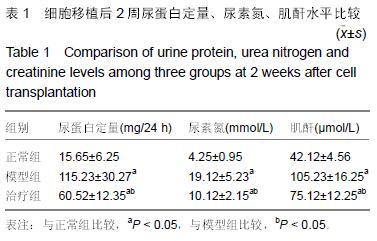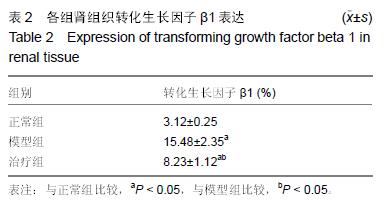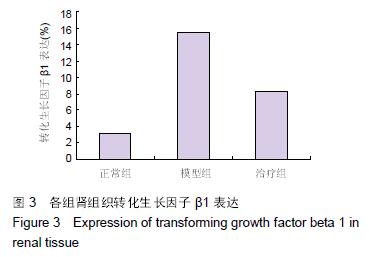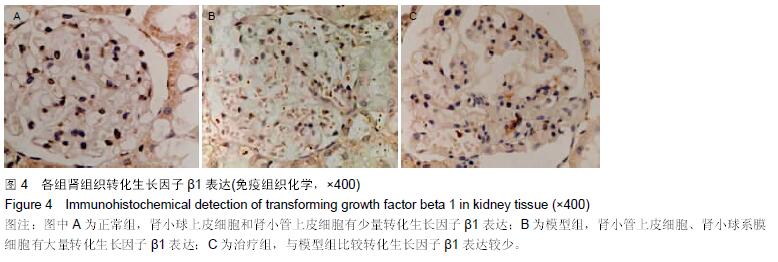| [1] 邹杰,冯江敏,李维,等.骨髓间充质干细胞在慢性马兜铃酸肾病大鼠肾脏中向肾小管周毛细血管丛内皮细胞的分化[J].中华医学杂志,2008,88(10):705-710. [2] 张蕊,任野平,高秀海,等.骨髓间充质干细胞对系膜增生性肾炎的修复作用及机制探讨[J].哈尔滨医科大学学报, 2011,45(6):544-549. [3] 王曌华.骨髓间充质干细胞在狼疮肾炎治疗中的研究进展[J].国际泌尿系统杂志,2010,30(2):237-241. [4] 彭伟,刘郑荣,任昊,等.骨髓间充质干细胞促进大鼠IgA肾病修复[J].中华肾脏病杂志,2008,24(10):743-750. [5] 徐璐,廖德怀,陈正,等.肾移植中经移植肾动脉输注骨髓间充质干细胞3例报告[J].中国组织工程研究与临床康复, 2010,14(53):10049-10052. [6] 赵红梅,胡祥,李芳,等.骨髓间充质干细胞在肾脏疾病中的应用[J].中国组织工程研究与临床康复,2010,14(23): 4329-4332. [7] Chang JW, Hung SP, Wu HH, et al. Therapeutic effects of umbilical cord blood-derived mesenchymal stem cell transplantation in experimental lupus nephritis. Cell Transplant. 2011;20(2):245-257. [8] El Kossi MM, Haylor JL, Johnson TS, et al. Stem cell factor in a rat model of serum nephrotoxic nephritis. Nephron Exp Nephrol. 2008;108(1):e1-e10. [9] 金碧辉.骨髓间充质干细胞对系膜增生性肾小球肾炎的修复作用[D]. 哈尔滨:哈尔滨医科大学,2008. [10] 黄金棋.骨髓间充质干细胞治疗系统性红斑狼疮鼠机制及疗效评价[D]. 福州:福建医科大学,2010. [11] 董海芸.骨髓间充质干细胞移植在肾脏疾病防治中的应用[J].中国组织工程研究与临床康复,2007,11(50): 10146-10149. [12] 董旭.骨髓间充质干细胞对Thy1系膜增生性肾小球肾炎的作用[D]. 哈尔滨:哈尔滨医科大学,2008. [13] Terrier B, Delmas Y, Hummel A, et al. Post-allogeneic haematopoietic stem cell transplantation membranous nephropathy: clinical presentation, outcome and pathogenic aspects. Nephrol Dial Transplant. 2007; 22(5):1369-1376. [14] 卫静.BMP-7基因修饰骨髓间充质干细胞治疗IgA肾病的实验研究[D].重庆:第三军医大学,2008. [15] Zhang L, Li K, Liu X, et al. Repeated systemic administration of human adipose-derived stem cells attenuates overt diabetic nephropathy in rats.Stem Cells Dev. 2013;22(23):3074-3086. [16] 马晓蕾,顾志峰,黄静,等.异基因骨髓间充质干细胞移植抑制B细胞活化缓解狼疮肾炎[C].西安:第15次全国风湿病学学术会议论文集,2010:144-145. [17] 陈洁,张智,曾慧兰,等.骨髓间充质干细胞预处理脑死亡供鼠对移植肾的保护作用[J].中华器官移植杂志,2015, 36(6): 362-366. [18] Ma X, Che N, Gu Z, et al. Allogenic mesenchymal stem cell transplantation ameliorates nephritis in lupus mice via inhibition of B-cell activation. Cell Transplant. 2013; 22(12):2279-2290. [19] Zoja C, Garcia PB, Rota C, et al. Mesenchymal stem cell therapy promotes renal repair by limiting glomerular podocyte and progenitor cell dysfunction in adriamycin-induced nephropathy. Am J Physiol Renal Physiol. 2012;303(9):F1370-1381. [20] Liu H, Liu F, Peng Y, et al. Role of mast cells, stem cell factor and protease-activated receptor-2 in tubulointerstitial lesions in IgA nephropathy. Inflamm Res. 2010;59(7):551-559. [21] 吴岩.间充质干细胞治疗慢性间质性肾炎动物模型意义初探[D].沈阳:中国医科大学,2010. [22] Iwata Y, Wada T, Uchiyama A, et al. Remission of IgA nephropathy after allogeneic peripheral blood stem cell transplantation followed by immunosuppression for acute lymphocytic leukemia. Intern Med. 2006;45(22): 1291-1295. [23] Shaughnessy PJ, Ririe DW, Ornstein DL, et al. Graft failure in a patient with systemic lupus erythematosus (SLE) treated with high-dose immunosuppression and autologous stem cell rescue. Bone Marrow Transplant. 2001;27(2):221-224. [24] Marmont AM, Gualandi F, van Lint MT, et al. Long term complete remission of severe nephrotic syndrome secondary to diffuse global (IV-G) lupus nephritis following autologous, haematopoietic peripheral stem (CD34+) cell transplantation. Lupus. 2006;15(1):44-46. [25] Huang X, Qin W, Zhang M, et al. Detection of anti-PLA2R autoantibodies and IgG subclasses in post-allogeneic hematopoietic stem cell transplantation membranous nephropathy. Am J Med Sci. 2013;346(1): 32-37. [26] Navaneethan SD, Taylor J, Goldman B, et al. Anti-neutrophil cytoplasmic antibody associated crescentic IgA nephropathy in hematopoietic stem cell transplantation. Clin Nephrol. 2009;71(1):59-62. [27] Zenz T, Schlenk RF, Glatting G, et al. Bone marrow transplantation nephropathy after an intensified conditioning regimen with radioimmunotherapy and allogeneic stem cell transplantation. J Nucl Med. 2006; 47(2):278-286. [28] Wang S, Li Y, Zhao J, et al. Mesenchymal stem cells ameliorate podocyte injury and proteinuria in a type 1 diabetic nephropathy rat model. Biol Blood Marrow Transplant. 2013;19(4):538-546. [29] 刘仁华.造血干细胞联合间充质干细胞共移植治疗鼠系统性红斑狼疮的实验研究[D].湛江:广东医学院,2011. [30] Chang JW, Hung SP, Wu HH, et al. Therapeutic effects of umbilical cord blood-derived mesenchymal stem cell transplantation in experimental lupus nephritis. Cell Transplant. 2011;20(2):245-257. [31] 纳宁,黄正宇,洪良庆,等.输注重组GDNF过表达的间质干细胞改善肾毒性血清肾炎肾功能[J].中山大学学报:医学科学版,2011,32(5):600-605. [32] Huang ZY, Hong LQ, Na N, et al. Infusion of mesenchymal stem cells overexpressing GDNF ameliorates renal function in nephrotoxic serum nephritis. Cell Biochem Funct. 2012;30(2):139-144. [33] 景红,宋红梅,魏珉,等.骨髓干细胞在IgA肾病发病机制中的作用[J].国际儿科学杂志,2006,33(5):332-334. [34] 马之学,尹智炜,王丹云,等.干细胞移植治疗IgA肾病1例[J].临床荟萃,2010,25(23):2100. |
.jpg)






.jpg)